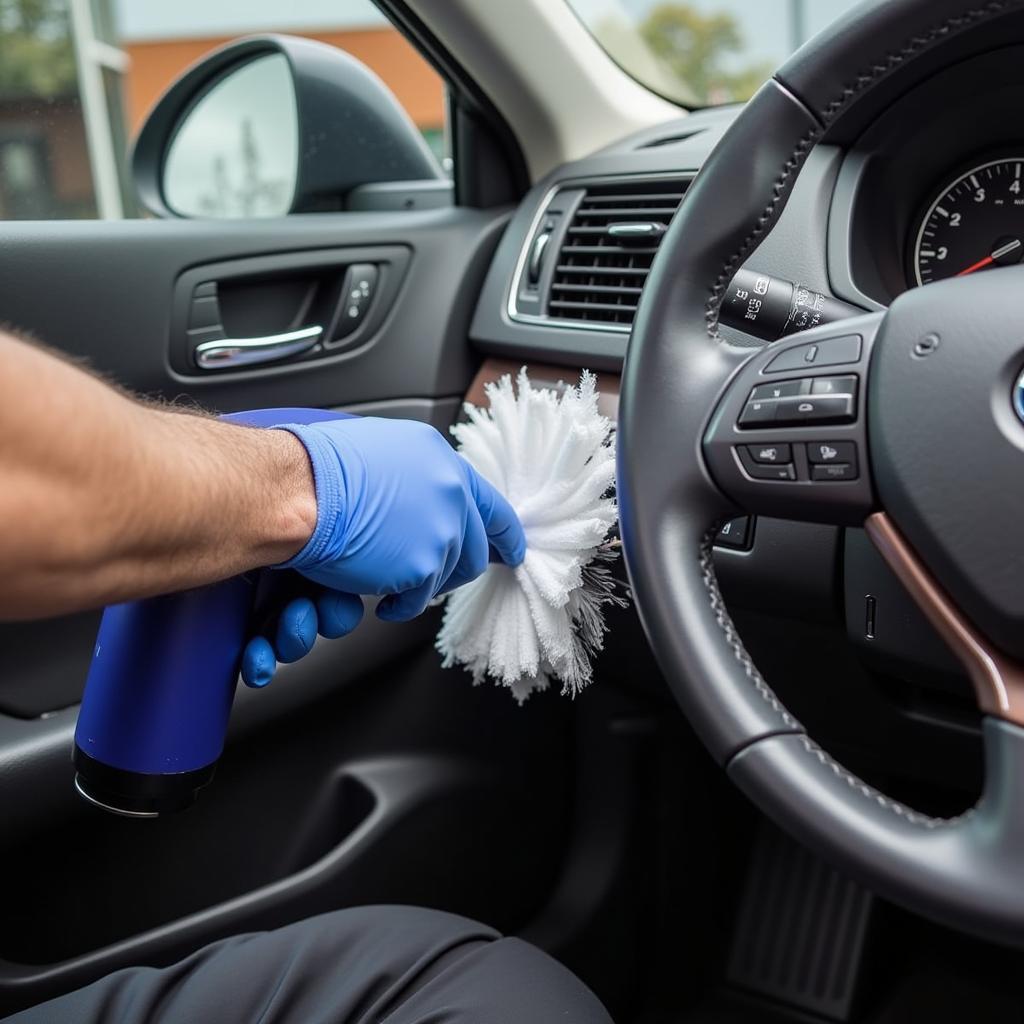When you get your car detailed, you expect a pristine finish inside and out. But have you ever wondered about the process, particularly how detailers achieve that professionally dried interior? It’s more than just leaving the windows down! This article delves into the techniques professionals use to ensure your car’s interior is thoroughly dry, preventing musty smells and potential damage.
Why Drying Your Car Interior Properly Matters
Before we explore the “how,” let’s understand the “why.” A damp car interior isn’t just an inconvenience; it can lead to several issues:
- Mildew and Mold: Moisture creates a breeding ground for mildew and mold, leaving unsightly stains and unpleasant odors.
- Material Damage: Prolonged exposure to dampness can warp leather, fade fabrics, and damage electronic components.
- Unpleasant Odors: That musty smell? It’s a telltale sign of trapped moisture.
Tools of the Trade: What Professionals Use
Car detailers employ specific tools to effectively dry your car’s interior:
- Microfiber Towels: Highly absorbent, these are the workhorses of drying, used on various surfaces.
- Compressed Air: Powerful bursts of air reach tight crevices and under seats, effectively removing hidden moisture.
- Heater/ Blower: Used in conjunction with open doors, this speeds up the drying process, particularly for carpets and upholstery.
- Moisture Eliminator: Products like DampRid absorb excess moisture from the air, further aiding the drying process.
The Drying Process: A Step-by-Step Guide
Detailers follow a systematic approach to ensure every nook and cranny is dry:
- Removal of Excess Water: The process begins with removing standing water. This might involve vacuuming up spills or using towels to soak up excess liquid.
- Wiping Down Surfaces: All hard surfaces, including the dashboard, steering wheel, and door panels, are meticulously wiped down with microfiber towels.
- Tackling Upholstery and Carpets: Detailers use a combination of extraction methods, microfiber towels, and air blowers to remove moisture from fabric surfaces.
- The Power of Air: Compressed air is directed into tight spaces – seat crevices, air vents, and under floor mats – blasting away any lingering moisture.
- Final Inspection: Before returning your car, detailers conduct a final inspection, ensuring all surfaces are dry and free from streaks.
 Car detailer using an air blower on car vents
Car detailer using an air blower on car vents
Expert Tips for a Perfectly Dried Car Interior
Here are some expert tips to keep in mind:
- Choose a reputable detailer: Experience matters! Look for detailers who prioritize proper drying techniques. Why invest in a car detailer?
- Ask about their drying process: Don’t hesitate to inquire about the specific methods used to dry your car’s interior.
- Don’t rush the process: Allow sufficient drying time, especially if you live in a humid climate.
DIY Drying: Can You Do It Yourself?
While professional detailing yields the best results, you can help maintain a dry car interior between visits:
- Keep it clean: Regularly vacuum and wipe down surfaces to prevent dirt and spills from trapping moisture.
- Address spills immediately: Don’t let spills linger. Blot them up quickly with a clean cloth.
- Air it out: On sunny days, park your car with the windows slightly open to allow for air circulation.
How Much Does Drying Your Car Interior Cost?
Drying is usually included as part of a full car detail. How much is a full car detail? However, some detailers may offer this service separately, particularly after an interior shampoo.
Conclusion
Thoroughly drying your car’s interior is crucial for maintaining its appearance, preventing damage, and eliminating odors. While DIY methods can help, nothing beats the expertise and specialized tools of a professional detailer. Remember, a dry car is a happy car!
FAQs
Q: Can I just leave my car windows down to dry the interior?
A: While cracking the windows can help with ventilation, it’s not an effective way to fully dry the interior, especially in carpets, upholstery, and tight spaces.
Q: How long does it take to dry a car interior professionally?
A: The drying time can vary depending on the level of moisture, the size of the car, and the drying methods used. It can range from a couple of hours to a full day.
Q: What happens if my car interior isn’t dried properly?
A: Improper drying can lead to mold and mildew growth, unpleasant odors, and potential damage to your car’s interior materials.

Leave a Reply